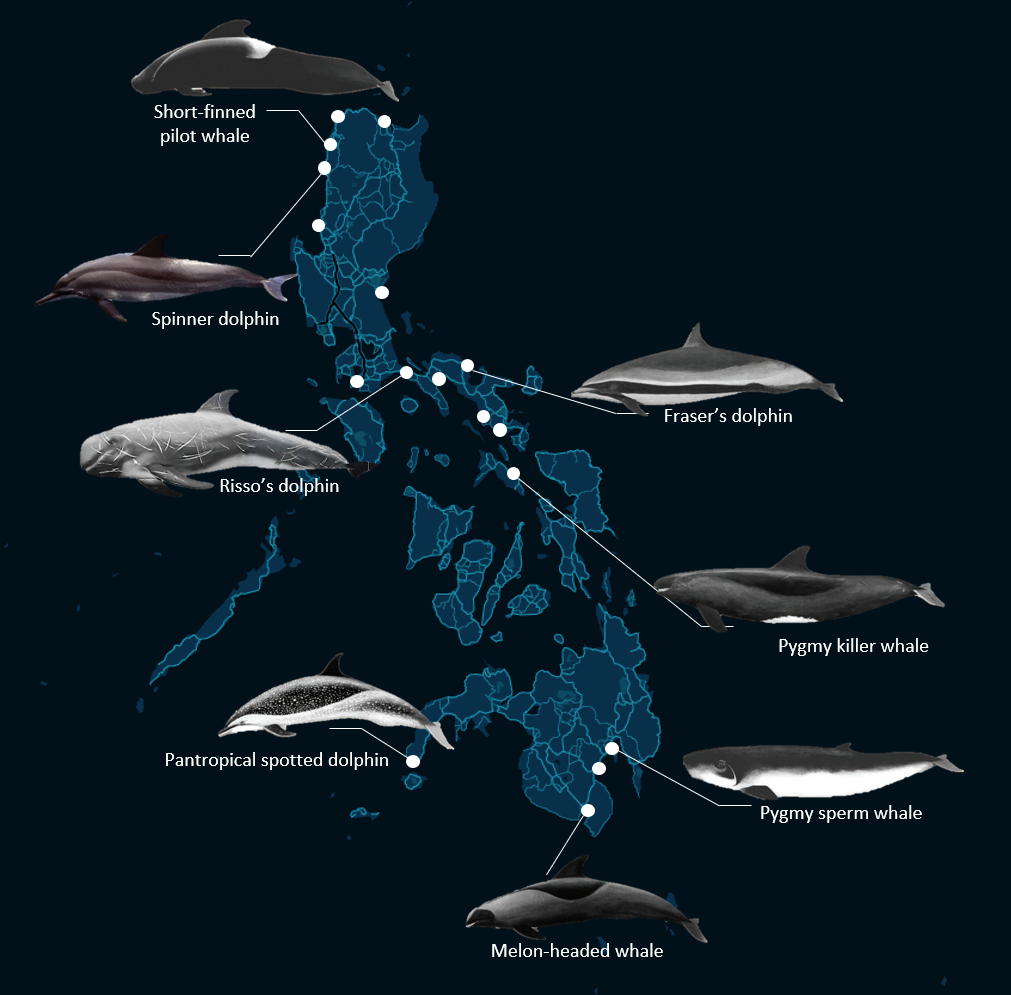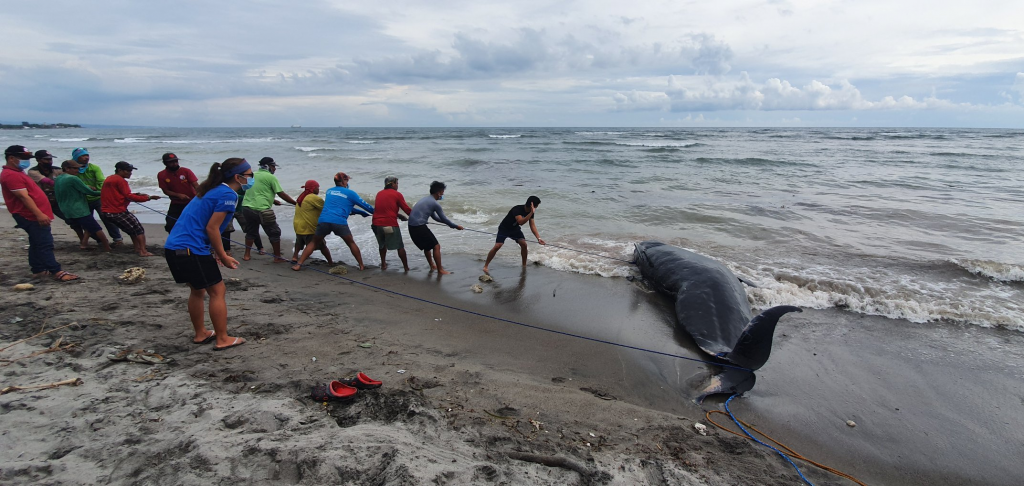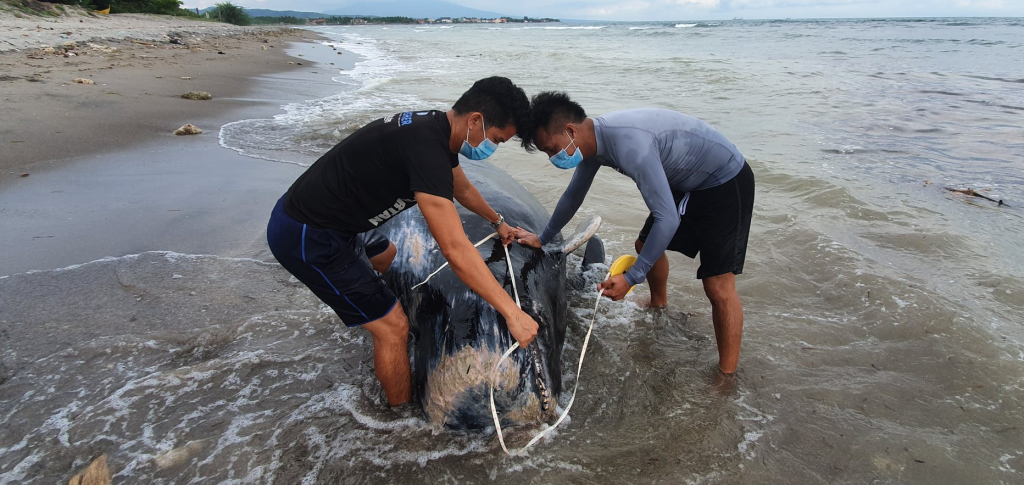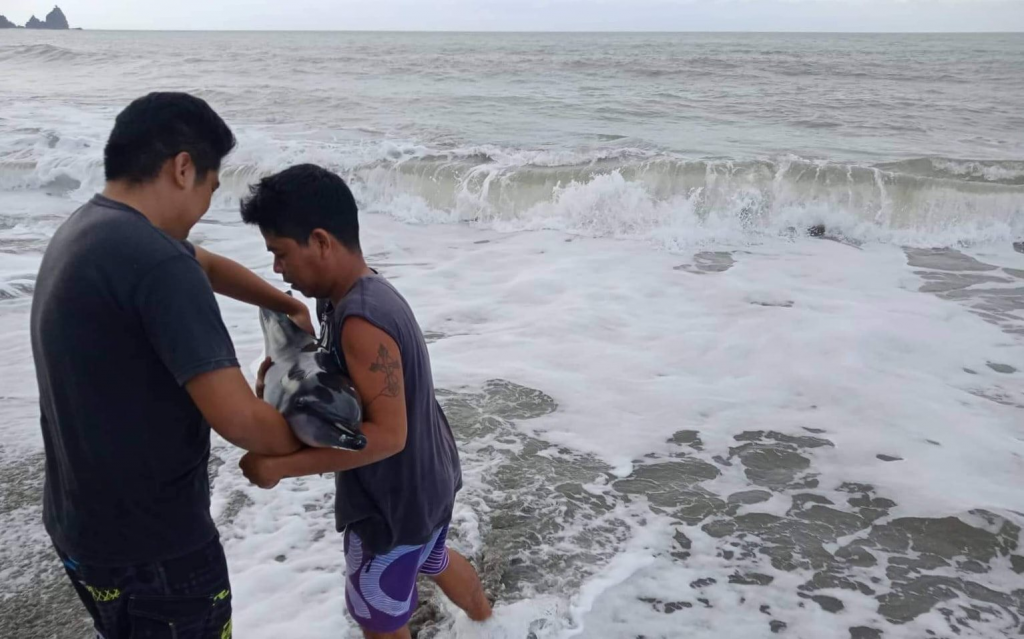Bacteriological and histopathological findings in cetaceans that stranded in the Philippines from 2017 to 2018
Preprint posted on 30 November 2020 https://www.biorxiv.org/content/10.1101/2020.11.30.403568v1
Article now published in PLOS ONE at http://dx.doi.org/10.1371/journal.pone.0243691
Navigating change: sentinels of the sea tell about ocean health and disease.
Selected by Paul Gerald L. Sanchez and Stefano VianelloCategories: ecology, epidemiology, pathology, pharmacology and toxicology, zoology
Overview and context
Around 70% of our planet is covered in water, with ~130 species of mammals living within oceanic ecosystems. Central to this preprint is the concept of sentinel organisms, whereby marine mammals can be seen as monitors and relayers of information about oceanic health (Bossart, 2011). Accordingly, monitoring the state of marine mammals can provide early reports of changing environmental pressures, as well as early warning signs of health threats, stressors, disease.
Indirectly, and through reporting on the health of their own populations and of their environment, marine sentinels also provide information about imminent health, environmental, and economic threat to the livelihood of the human communities associated with them. Putting the urgency of the matter in perspective, coastal areas bordering oceanic ecosystems are home of around 40% of the world’s human population.

Figure 1: sites of cetacean stranding in the Philippines in the year 2017-2018 (adapted from preprint Figure 1). Map is from snazzymaps.com (public domain). Cetaceans are from The Philippines’ Bureau of Fisheries and Aquatic Resources (“Protected Philippine aquatic wildlife” poster; CC-BY SA)
Stranding events of e.g. whales and dolphins, as tragic as they may be, represent a practical opportunity to interact with some of these marine mammal sentinels, and to collect the information they may carry with them. In the Philippines, a network of experts, professionals and volunteers (the Philippine Marine Mammal Stranding Network) readily mobilises upon stranding events, and as such allows not only rehabilitation and rescue of the animals, but also investigation of the cause of stranding, and sample collection.
In this study, the authors analyse histopathological and bacteriological samplings from 21 stranding events on Philippines coasts (see Figure 1). Crucially, these findings uncover troubling levels of multiple antibiotic resistance within bacterial populations of oceanic ecosystems, as well as histopathological evidence that cetacean may act as hosts of protozoan disease with zoonotic potential (specifically, Toxoplasma gondii). In practice, marine sentinel organisms are relaying forewarnings of significant threats to human health, while bearing the burden of increasing anthropogenic degradation of coastal and oceanic ecosystems.
Key Results
Histopathological findings
The authors perform histopathological examination of tissue samples obtained from stranded cetaceans. Many of the lesions observed are expectedly consequences of the trauma and stress associated with the stranding event itself: a stranded marine mammal will indeed quickly develop congestion of its internal tissues due to its body weight not being supported by water anymore.
Yet, other lesion types report environmental and parasitic stresses. Among many other lesion types, the authors document significant cases of glomerulopathy: a condition which has elsewhere been speculatively associated with chronic exposure to heavy metals. Even more jarringly, the authors provide the first histopathological evidence of Toxoplasma infection within local cetaceans. Infection by this parasite is most likely to originate from anthropogenic sewage runoff, and represents a potential threat also to humans if cetacean meat was to be consumed.
Bacteriological findings
Bacterial swabs from both external and internal areas of stranded cetaceans show species of Enterobacter, Escherichia, Klebsiella, Proteus, and Shigella bacteria. Very worryingly, the authors find that 79% of the sampled bacterial populations display multiple antibiotic resistance, some being resistant to up to 39% of the (18) antibiotics tested. Great point of concern is the detection of resistance against multiple carbapenems, currently considered the last available line of defence in antibacterial fight. The inference is that of heavily antibiotic contaminated surface waters, through which whales and dolphins are forced to navigate as they periodically resurface for air.



Figure 2: Photos of rescue operations. From the “Friends of Philippine Marine Mammal Stranding Network” Facebook page. Reused with permission
Significance
This study highlights the relevance of “sentinel organism” frameworks in the monitoring of oceanic and marine mammal health, and how such frameworks link these dimensions to human livelihood. Of note, the paper informs better strategies for marine mammal rescue, rehabilitation, and conservation (e.g. the identification of most effective antibiotic combinations for the treatment of stranded cetaceans), and documents a considerable protozoan burden in these animals.
Most significantly however, the paper highlights striking challenges faced by cetaceans in the wild, and pathophysiology consistent with poor oceanic quality and strong anthropogenic burden. The documentation of bacterial populations with multiple antibiotic resistance, and resistance to “last line of defence” antibiotics, is particularly jarring.
Questions to the authors (please see response below):
- Do you believe parasitic burden and antibiotic resistance are nowadays a burden for cetaceans across the globe? Or would it just affect animals living in waters close to areas of high human activity?
- Could you share some successes and struggles of doing research like this in the Philippines? How can the findings from your study impact policy (of animal conservation, water management, or health), locally and internationally?
- You have found many animals with parasitic cysts. While the consumption of cetacean meat is illegal in the Philippines, you do envisage a threat of zoonotic transmission. Do you believe marine mammals could represent a reservoir for the resurgence of disease?
- The current pandemic has highlighted once again the threat represented by animal-to-human viral zoonosis. Is anything known about cetaceans and viruses? Would the collection of viral information be possible from stranded cetaceans?
References and further reading
- Bossart, Gregory D. “Marine mammals as sentinel species for oceans and human health.” Veterinary pathology 48.3 (2011): 676-690.
- Obusan, Marie Christine M., et al. “Antibiotic Susceptibility Patterns of Bacteria Isolated from Cetaceans Stranded in the Philippines.” Aquatic Mammals 44.5 (2018): 568-579.
Posted on: 13 January 2021 , updated on: 14 January 2021
doi: https://doi.org/10.1242/prelights.26953
Read preprintHave your say
Sign up to customise the site to your preferences and to receive alerts
Register hereAlso in the ecology category:
Pervasive sublethal effects of agrochemicals as contributing factors to insect decline
Multimodal interactions in Stomoxys navigation reveals synergy between olfaction and vision
Generalized Biomolecular Modeling and Design with RoseTTAFold All-Atom
Also in the epidemiology category:
Multimodal interactions in Stomoxys navigation reveals synergy between olfaction and vision
Mapping current and future thermal limits to suitability for malaria transmission by the invasive mosquito Anopheles stephensi
Isolation disrupts social interactions and destabilizes brain development in bumblebees
Also in the pathology category:
Hypoxia blunts angiogenic signaling and upregulates the antioxidant system in elephant seal endothelial cells
H2O2 sulfenylates CHE linking local infection to establishment of systemic acquired resistance
Bacterial filamentation is an in vivo mechanism for cell-to-cell spreading
Also in the pharmacology and toxicology category:
Pervasive sublethal effects of agrochemicals as contributing factors to insect decline
Mixed Alkyl/Aryl Phosphonates Identify Metabolic Serine Hydrolases as Antimalarial Targets
Optical Control of G-Actin with a Photoswitchable Latrunculin
Also in the zoology category:
Unlocking the secrets of kangaroo locomotor energetics: Postural adaptations underpin increased tendon stress in hopping kangaroos
Multimodal interactions in Stomoxys navigation reveals synergy between olfaction and vision
Torpor energetics are related to the interaction between body mass and climate in bats of the family Vespertilionidae
preLists in the ecology category:
EMBO | EMBL Symposium: The organism and its environment
This preList contains preprints discussed during the 'EMBO | EMBL Symposium: The organism and its environment', organised at EMBL Heidelberg, Germany (May 2023).
| List by | Girish Kale |
Bats
A list of preprints dealing with the ecology, evolution and behavior of bats
| List by | Baheerathan Murugavel |
Also in the epidemiology category:
BioMalPar XVI: Biology and Pathology of the Malaria Parasite
[under construction] Preprints presented at the (fully virtual) EMBL BioMalPar XVI, 17-18 May 2020 #emblmalaria
| List by | Dey Lab, Samantha Seah |
1
COVID-19 / SARS-CoV-2 preprints
List of important preprints dealing with the ongoing coronavirus outbreak. See http://covidpreprints.com for additional resources and timeline, and https://connect.biorxiv.org/relate/content/181 for full list of bioRxiv and medRxiv preprints on this topic
| List by | Dey Lab, Zhang-He Goh |
1
Antimicrobials: Discovery, clinical use, and development of resistance
Preprints that describe the discovery of new antimicrobials and any improvements made regarding their clinical use. Includes preprints that detail the factors affecting antimicrobial selection and the development of antimicrobial resistance.
| List by | Zhang-He Goh |
Also in the pathology category:
Fibroblasts
The advances in fibroblast biology preList explores the recent discoveries and preprints of the fibroblast world. Get ready to immerse yourself with this list created for fibroblasts aficionados and lovers, and beyond. Here, my goal is to include preprints of fibroblast biology, heterogeneity, fate, extracellular matrix, behavior, topography, single-cell atlases, spatial transcriptomics, and their matrix!
| List by | Osvaldo Contreras |
ECFG15 – Fungal biology
Preprints presented at 15th European Conference on Fungal Genetics 17-20 February 2020 Rome
| List by | Hiral Shah |
COVID-19 / SARS-CoV-2 preprints
List of important preprints dealing with the ongoing coronavirus outbreak. See http://covidpreprints.com for additional resources and timeline, and https://connect.biorxiv.org/relate/content/181 for full list of bioRxiv and medRxiv preprints on this topic
| List by | Dey Lab, Zhang-He Goh |
1
Cellular metabolism
A curated list of preprints related to cellular metabolism at Biorxiv by Pablo Ranea Robles from the Prelights community. Special interest on lipid metabolism, peroxisomes and mitochondria.
| List by | Pablo Ranea Robles |
Also in the pharmacology and toxicology category:
FENS 2020
A collection of preprints presented during the virtual meeting of the Federation of European Neuroscience Societies (FENS) in 2020
| List by | Ana Dorrego-Rivas |
COVID-19 / SARS-CoV-2 preprints
List of important preprints dealing with the ongoing coronavirus outbreak. See http://covidpreprints.com for additional resources and timeline, and https://connect.biorxiv.org/relate/content/181 for full list of bioRxiv and medRxiv preprints on this topic
| List by | Dey Lab, Zhang-He Goh |
1
Drug use in special populations
Any drugs that are being used in special populations: Patients with liver and kidney failure, in paediatrics, in geriatrics, and in pregnant or lactating patients. Includes the discovery of factors that could potentially affect drug use in these special populations.
| List by | Zhang-He Goh |
Toxicology of toxicants, existing therapeutics, and investigational drugs
Preprints that describe the toxicology of environmental pollutants and existing and upcoming drugs. Includes both toxicokinetics and toxicodynamics, as well as technological improvements that will help in the characterisation of this field.
| List by | Zhang-He Goh |
Antimicrobials: Discovery, clinical use, and development of resistance
Preprints that describe the discovery of new antimicrobials and any improvements made regarding their clinical use. Includes preprints that detail the factors affecting antimicrobial selection and the development of antimicrobial resistance.
| List by | Zhang-He Goh |
Anticancer agents: Discovery and clinical use
Preprints that describe the discovery of anticancer agents and their clinical use. Includes both small molecules and macromolecules like biologics.
| List by | Zhang-He Goh |
Advances in Drug Delivery
Advances in formulation technology or targeted delivery methods that describe or develop the distribution of small molecules or large macromolecules to specific parts of the body.
| List by | Zhang-He Goh |











 (No Ratings Yet)
(No Ratings Yet)
3 years
Emmanuel Macapagal
This is a great question! There is such thing as the cetacean morbillivirus (CeMV). This is a virus that infects cetaceans, which includes dolphins, porpoises, and whales.” -mY QUESTION IS ON the nature of clinical signs of this in marine mammals because there is a known as Canine Paramyxovirus with Morbillivirus as its genus. Would it be neurologic that might somehow be the cause of “seizures” that cause them to loose their bearings and get adrift and land on shores, dead.